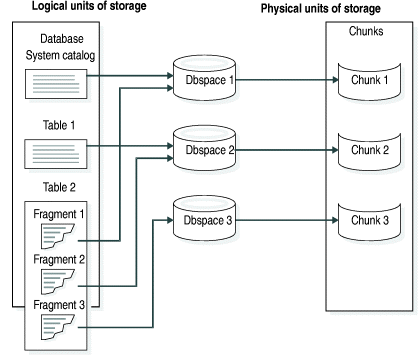
A logical-volume manager (LVM) is a utility that allows you to manage your disk space through logical volumes.
Many computer manufacturers ship their computers with a proprietary LVM. You can use the database server to store and retrieve data on disks that are managed by most proprietary LVMs. Logical-volume managers provide some advantages and some disadvantages, as discussed in the remainder of this section.
Most LVMs can manage multiple gigabytes of disk space. On Extended Parallel Server, the maximum chunk size can be 4 gigabytes or even larger for 64-bit platforms. To determine which chunk size your platform supports, refer to your machine notes file.
Because LVMs allow you to partition a disk drive into multiple volumes, you can control where data is placed on a given disk. You can improve performance by defining a volume that consists of the middle-most cylinders of a disk drive and placing high-use tables in that volume. For more information, see Place High-Use Tables on Middle Partition of Disk. (Technically, you do not place a table directly in a volume. You must first allocate a chunk as a volume, then assign the chunk to a dbspace, and finally place the table in the dbspace. For more information, see Control of Where Data Is Stored.)
You can also improve performance by using a logical volume manager to define a volume that spreads across multiple disks and then placing a table in that volume. This strategy helps reduce contention between programs that access the same table, as explained in Place High-Use Tables on Middle Partition of Disk.
Many logical volume managers also allow a degree of flexibility that standard operating-system format utilities do not. One such feature is the ability to reposition logical volumes after you define them. Thus getting the layout of your disk space right the first time is not so critical as with operating-system format utilities.
LVMs often provide operating-system-level mirroring facilities. For more information, see Alternatives to Mirroring.
Figure 68 illustrates the role of fragments in specifying the location of data.

Usually you fragment a table when you initially create it. The CREATE TABLE statement takes one of the following forms:
CREATE TABLE tablename ... FRAGMENT BY ROUND ROBIN IN dbspace1, dbspace2, dbspace3; CREATE TABLE tablename ...FRAGMENT BY EXPRESSION <Expression 1> in dbspace1, <Expression 2> in dbspace2, <Expression 3> in dbspace3;
The FRAGMENT BY ROUND ROBIN and FRAGMENT BY EXPRESSION keywords refer to two different distribution schemes. Both statements associate fragments with dbspaces. For more information on fragmentation schemes, refer to the IBM Informix: Database Design and Implementation Guide.
Home | [ Top of Page | Previous Page | Next Page | Contents | Index ]